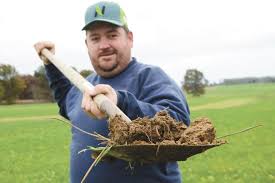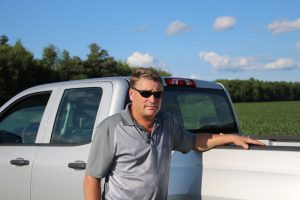Agronomy, Conservation, Homepage Slider, Water Quality
The Dirt on Soil Health
By Dusty Sonnenberg, CCA, Ohio Field Leader: a project of the Ohio Soybean Council and soybean checkoff.
The Ohio State University’s College of Food Agricultural and Environmental Science is hosting a web series titled “The Dirt on Soil Health”. The first session delt with “Improving Soil Health on Your Farm”. On the first program, a three-farmer panel shared their experiences, and offered advise to other farmers wanting to improve their soil health and profitability.
Les Siler, a farmer from Fulton County, said farmers need to be intentional to improve the quality and health of their soil. “Treat the soil like a living thing,” said Siler. “You need to take care of it, keep it covered and not tear it up.”
Nathan Brown, a farmer from Highland County, believes farmers need to allow the soil to function as it was created to.

“We need to make sure that the soil has the ability to function the way nature intended,” said Brown. “There are a number of things in the soil that we need to work to keep alive and functioning. We want to recycle nutrients and raise the healthiest crops possible that will make it profitable for me and also for future generations.”
When defining soil health from an organic standpoint, Matt Falb, a farmer from Wayne County, feels it involves the capacity of the soil to support plant growth. “I learned from my Dad that soil health involves the chemical and physical side, and in the last decade we are learning more about the biological side. I just learned in a program the other day, that there are over 4 tons of living organisms in each acre of soil.”
One theme that emerged was that the idea of treating the soil is a “living” thing. “Farmers need to grow the ‘herd’ of organisms below the soil surface, and help regenerate the soil,” said Brown. There are a number of factors that go into growing the ‘herd’ or organisms. The use of cover crops is one key to feeding the organisms. “When we started growing cover crops, it was primarily to reduce erosion. We then saw the benefits in the soil health,” said Brown.
Along with the use of cover crops, having a multiple crop rotation is beneficial.

“Crop diversity is very beneficial to the soil health and the soil life,” said Siler. “Farmers also need to think about anything they do to the soil. If it is applying fertilizer or making a tillage pass. They need to think about how that impacts building the soil.”
Keeping the soil covered the majority of the year also helps feed the soil microbiology. “I think it starts with having a ground cover on our farm as long during the year as possible,” said Falb. “That contributes to trying to grow our own nutrients and increasing organic matter. With organic farming, or synthetic inputs are restricted, so we need to find ways to grow our own nutrients. Weed control is also a challenge with organic operations, and having ground cover helps suppress weeds throughout the season.”
“When we started to transition to organic production, we had to figure out how to grow our own nitrogen, and that led us to look into what legumes or other cover crops we could incorporate in,” said Falb. “Because we grow small grains for straw for our cattle, that provided a good window to establish cover crops in the fall for plow-down in the spring.”
The decision of how and when to terminate a cover crop is another factor in improving soil health and increasing organic matter. “I used to want to have everything sprayed to terminate it by the end of April every year,” said Brown. “I really got to thinking about the organic matter that I could be growing if I left that go. About four years ago we began to plant green and delayed our termination until after planting, and that has really been a game changer.”
The next “Dirt on Soil Health” program will take place on Thursday, January 21st beginning at 8:00 a.m. with the topic: “What can Soil Health Tests Tell You?” with Steve Culman from Ohio State as the featured speaker. To register visit: http://go.osu.edu/soilhealth2020